Overview
As in previous Republican presidential campaigns, most Americans (54%) are able to name at least one of the GOP candidates unprompted. However, smaller percentages name the leading candidates than in previous Republican races.
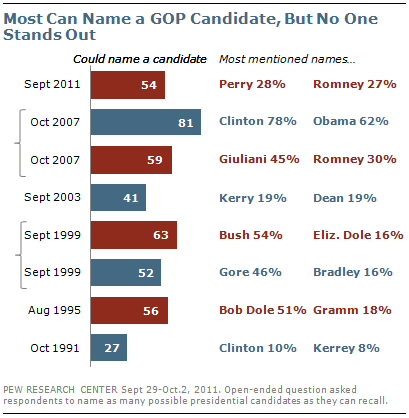
Just 28% name Texas Gov. Rick Perry and 27% name former Massachusetts Gov. Mitt Romney.
At this point in the race four years ago, Rudy Giuliani was far better known; 45% could name the former New York City mayor unprompted. Even more could name the two leading Democratic candidates at the time, Hillary Clinton (78%) and Barack Obama (62%).
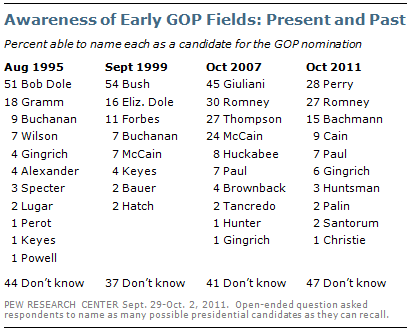
At this stage in the 2000 and 1996 Republican campaigns, far more named George W. Bush (54%) and Bob Dole (51%) than can recall the name of any of the current Republican candidates.
While Perry and Romney are running nearly even in mentions, Minnesota Rep. Michele Bachmann is running third with 15%. Herman Cain is mentioned by 9%, Ron Paul by 7% and Newt Gingrich by 6%. The other candidates are mentioned by 3% or fewer.
The latest weekly News Interest Index survey,conducted Sept. 29-Oct. 2 among 1,000 adults by the Pew Research Center for the People & the Press, finds that public interest in the campaign remains as high today as it was at this point in 2007, when there were contested races in both parties. In September, an average of 24% each week said they followed news about the campaign very closely. During the same month in 2007, an average of 21% each week said they followed campaign news that closely.
The economy continues to be the public’s most closely followed news story. A quarter (25%) say they followed news about the economy more closely than any other story, while 17% say they followed news about the presidential campaign most closely. The news media divided its focus between the 2012 elections (15% of all coverage) and the economy (14%), according to a separate analysis by the Pew Research Center’s project for Excellence in Journalism (PEJ).
The survey finds that 66% of Republicans and Republican-leaning independents are able name a Republican presidential candidate, which is on par with the percentage of Republicans and GOP-leaners that could name a Republican candidate in October 2007.
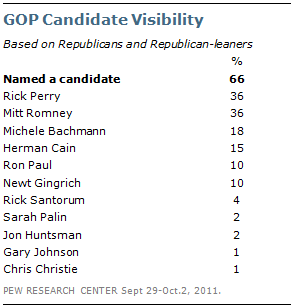
Perry and Romney receive the most mentions among Republicans and independents who lean Republican (36% each). Michele Bachmann is mentioned by 18%, Herman Cain by 15% and Ron Paul and Newt Gingrich by 10% each. Smaller numbers name the remaining candidates.
Chris Christie, who reaffirmed Oct. 4 that he is not running for president, was named by 1% of Republicans as a GOP candidate A large share of last week’s news coverage of the campaign centered on whether Christie would enter the race, according to PEJ. (See “Christie Speculation Gives Campaign Top Billing.”)
Among the public, 60% say they heard at least a little about the speculation that Christie might run for president, but only 28% heard a lot about this; 40% say they heard nothing at all about the possibility that the New Jersey governor might mount a campaign for president.
Interest in Campaign News
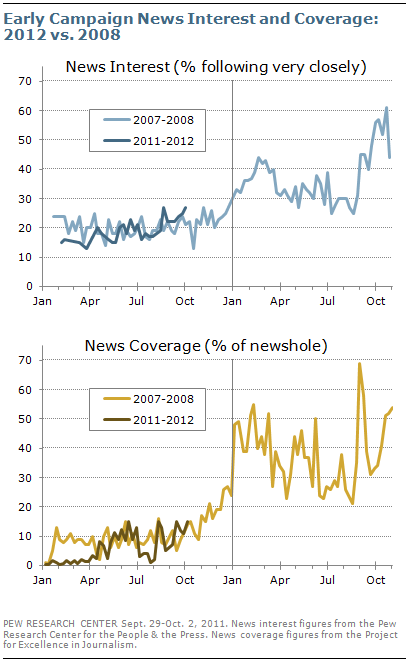
About a quarter of the public (27%) say they very closely followed news about the candidates for president in 2012 last week, a level little changed in recent weeks. Still, that’s up slightly from just before Labor Day, when 22% said they followed this news very closely. Nearly two-in-ten (17%) say they followed news about the candidates more closely than any other story. News about the campaign accounted for 15% of coverage last week.
So far, interest in campaign news remains similar to the levels seen in 2007. After a slow start early in 2011, coverage – measured as a percentage of the newshole examined by PEJ – has been comparable as well.
Republicans Follow Campaign More Closely
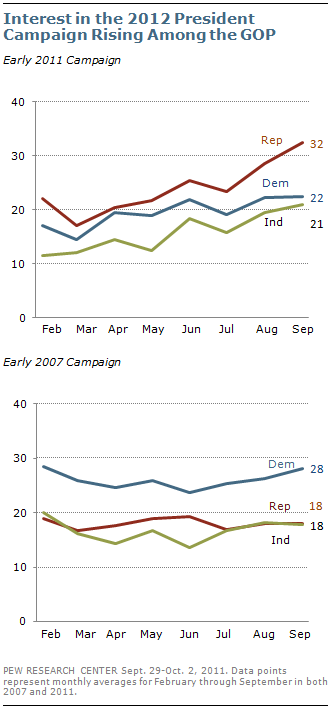
With their party engaged in the early stages of a battle for the nomination, Republicans are now following election news more closely than are Democrats or independents. Looking at monthly averages, 32% of Republicans followed campaign news very closely each week in September. That drops to 22% among Democrats and 21% among independents.
Attentiveness among Republicans has been rising as the year has unfolded. In June, for example, an average of 25% per week said they were following news about the candidates very closely. Interest among Democrats and independents is essentially unchanged since mid-year.
Republicans followed news about the candidates much more closely this September than they did in September 2007 (32% vs. 18% very closely). On the other hand, Democrats were more attentive four years ago as Clinton and Obama fought for the nomination. In September 2007, nearly three-in-ten Democrats (28%) said they were following news about the candidates very closely, compared with 22% in September 2011. Interest among independents is comparable to four years ago (21% now vs. 18% in 2007).
The Week’s News
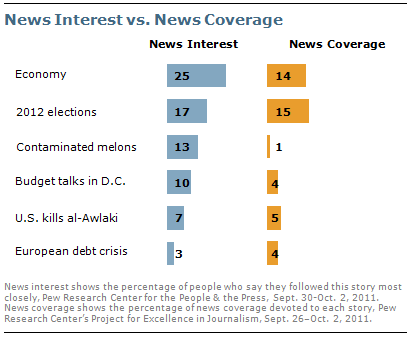
While the media divided its attention between news about the 2012 candidates for president and news about the economy, the public continued to focus most closely on news about the struggling economy.
A quarter of the public (25%) says that news about the condition of the economy was their top story of the week, while 17% say they followed news about the presidential campaign most closely.
Interest in news about the economy has changed little in recent weeks. Nearly half (46%) say they followed news about the economy very closely last week, about the same as one week earlier. News about the economy accounted for 14% of coverage, according to PEJ.
News about the candidates made up 15% of coverage. About a quarter (27%) say they followed campaign news very closely, again little changed from the previous week. More than a third of Republicans (37%) say they followed news about the candidates very closely, compared with 25% each of Democrats and independents.
More than one-in-ten (13%) say their top story was the outbreak of illnesses linked to contaminated cantaloupes. News about the listeria outbreak accounted for just 1% of coverage measured by PEJ. Women are much more likely than men to say this was the news they followed most closely (20% vs. 6%).
A quarter of the public (25%) says they followed news about the food contamination very closely. That’s slightly less than the 31% that tracked news about an egg recall very closely in August 2010 after an outbreak of salmonella.
One-in-ten (10%) say they most closely followed news about Congress working on a budget extension to avoid a government shutdown. About three-in-ten (31%) say they followed this news very closely. The budget fight in Washington made up 4% of coverage.
Another 7% say their top story was the killing of a U.S.-born al Qaeda leader in Yemen in an attack launched by a drone airplane. About a quarter (24%) say they very closely followed news about the death of Anwar al-Awlaki. The killing of the Muslim cleric and terrorist leader made up 5% of coverage.
The economic crisis in Europe garnered only modest attention; 3% say this was the story they followed most closely, while 15% say they followed this news very closely. The debt crisis accounted for 4% of coverage.
Using another measure, more than half of the public (55%) says they heard nothing at all last week about Amazon introducing a new tablet device known as the Kindle Fire. Just 11% say they heard a lot about this, while 33% say they heard a little.
In early 2010, many more heard about Apple introducing the iPad tablet. At that time, 24% said they had heard a lot about the new product and 44% said they had heard a little. About three-in-ten (31%) said they had heard nothing at all about the introduction.
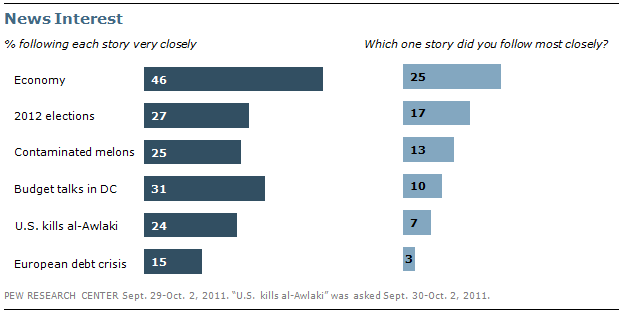
These findings are based on the most recent installment of the weekly News Interest Index, an ongoing project of the Pew Research Center for the People & the Press. The index, building on the Center’s longstanding research into public attentiveness to major news stories, examines news interest as it relates to the news media’s coverage. The weekly survey is conducted in conjunction with The Project for Excellence in Journalism’s News Coverage Index, which monitors the news reported by major newspaper, television, radio and online news outlets on an ongoing basis. In the most recent week, data relating to news coverage were collected Sept. 26-Oct. 2, and survey data measuring public interest in the top news stories of the week were collected Sept. 29-Oct. 2 from a nationally representative sample of 1,000 adults.


